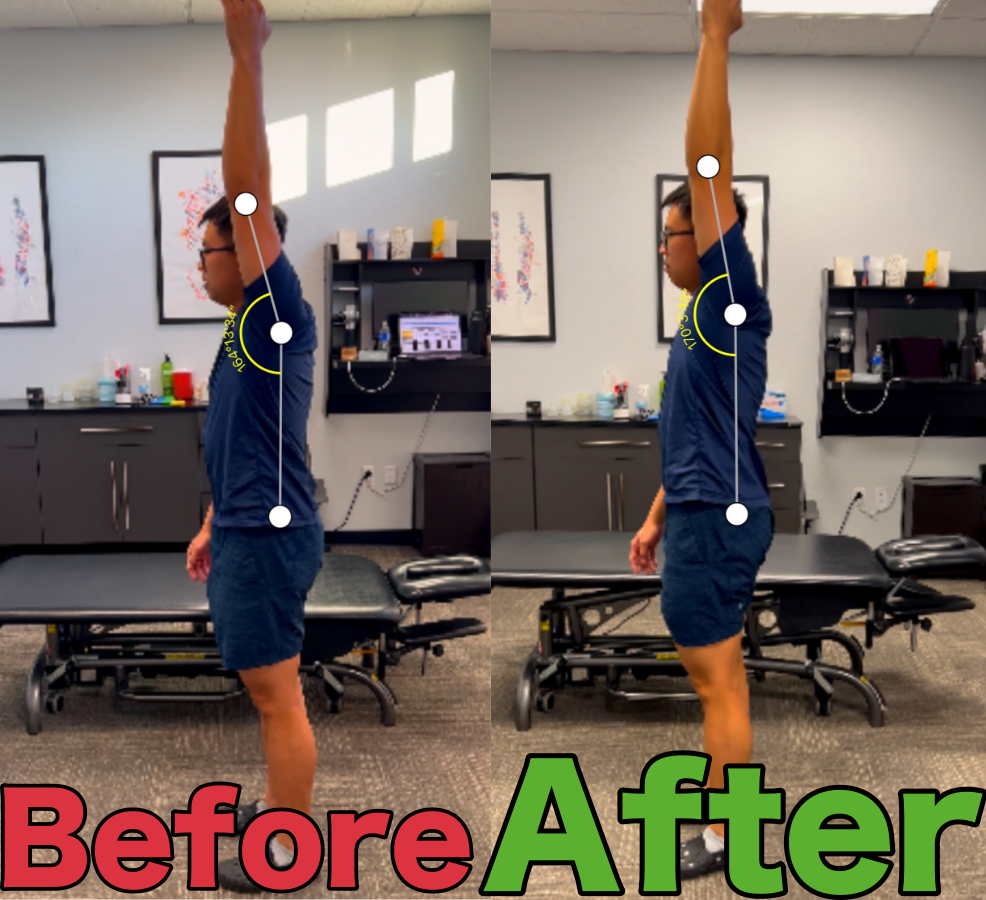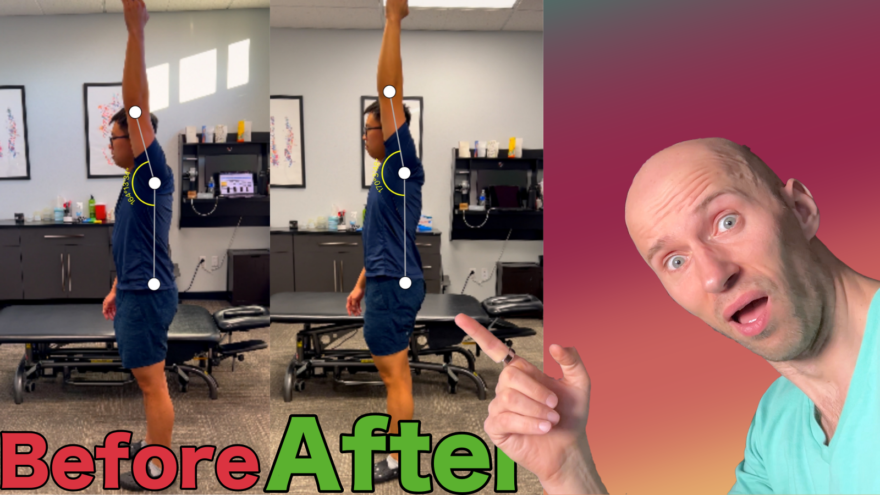Table of Contents
Does going overhead feel stuck? Then you MUST watch this case study
Full overhead motion is important for many sports, yet so few people have access to the full range. It’s super common to feel a block, stuck, or limited.
The issue?
There aren’t really any good solutions to getting more overhead. I mean, come on, we all know stretching doesn’t really cut it.
What if there was a way to remove that overhead block without a single stretch? Instead, just choosing the right weight room exercises for them mobility gains?
We did that in today’s case study. Watch us help someone with limited shoulder mobility, and see the 4 exercises (and one manual technique) that both increased shoulder mobility and removed that sense of feeling blocked. No stretch required 😉
Check out the video and case summary below.
Case overview
Today we are working with my friend Kevin, an Olympic weightlifter. He complains of a “blocked” sensation when he goes fully overhead with his left arm. He opted to work with YA BOI to try and see if we could remove this sensation.
Objective findings
Brad’s main initial findings were the following:
| Test | Left | Right |
| Infrasternal angle | wide | |
| Shoulder flexion | 0 | 0 |
| Shoulder external rotation | 85 | 85 |
| Shoulder Internal rotation | 90 | 90 |
| Hip flexion | 95 | 95 |
| Hip external rotation | 60 | 45 |
| Hip internal rotation | 40 | 45 |
| Straight leg raise | 65 | 65 |
| Hip extension/adduction | -10 | -10 |
| Lower cervical rotation | ++ | + |
After testing, we can see why should flexion might be feeling a bit blocked-Kevin has very little external rotation range of motion available. The drop-off of external rotation-biased shoulder flexion and external rotation are the major rate-limiting steps here.
So I know what you might be thinking. How do we get that mo’ betta?
If you’ve followed me for a minute, you might be thinking of choosing exercises that drive upper back/posterior thorax expansion.
But what if I told you there might be a different solution here?
Consider this. The upper body measures present classic for a wide infrasternal angle, namely, reduced external rotation.
But that’s not the case in the lower body. In fact, Kevin has near-full external rotation. How does that happen?
The answer folks, is a concentric rectus abdominis, which creates a depressed sternum and swayback posture. This strategy is a progressive compensatory action, and ought to be addressed first.
If I contract rectus abdominis, you will get an anterior thorax tilt, which magnifies the internal rotation but causes the external rotation to drop off in the upper body. In the lower body, it has the opposite effect; reduced internal rotation and increased external rotation.
Intervention selection
Given the findings above, the big focus for Kevin will be as follows:
- Establish lower ribcage position
- Reduce rectus abdominis muscle activity
- Drive left rotation to increase the external rotation needed to improve shoulder flexion
These are my thoughts upon reflection, but let’s see how it ACTUALLY played out.
Prone to supine roll
I chose this move to see if we could restore some of the leftward rotation. With the prone position, the air and viscera are pushed more anteriorly, which would create an eccentric position of the abs, getting rectus to chill. Therefore, it hits two out of Kevin’s three needs.
After performing this move, Kevin’s test results were as follows (improvements are bolded):
| Test | Left | Right |
| Infrasternal angle | wide | |
| Shoulder flexion | 0 | 0 |
| Shoulder external rotation | 90 | 88 |
| Shoulder Internal rotation | 90 | 90 |
| Hip flexion | 120 | 120 |
| Hip external rotation | 60 | 60 |
| Hip internal rotation | 40 | 45 |
| Straight leg raise | 75 | 75 |
| Hip extension/adduction | -10 | -10 |
| Lower cervical rotation | ++ | + |
Overall, some decent improvements, and we are starting to get some clearance of the shoulder external rotation, but sadly no change in shoulder flexion and cervical rotation. These two tests will play the biggest role in improving Kevin’s shoulder flexion capabilities.
Given that we still have a shoulder external rotation loss, my thought was to still minimize the rectus strategy, hence the next move!
Army crawl with head turn
I like this move because the prone position will minimize rectus abdominis engagement. The arm position being abducted will help promote external rotation, and minimize pec engagement. Pecs going bananas may contribute to the sternum being depressed.
Also, the head turn here will encourage some of the upper thorax rotation needed to get fully overhead. Because of the prone position, we can get Kevin to rotate without engaging rectus to make it happen.
Here were the results:
| Test | Left | Right |
| Infrasternal angle | wide | |
| Shoulder flexion | 25 | 45 |
| Shoulder external rotation | 90 | 88 |
| Shoulder Internal rotation | 90 | 90 |
| Hip flexion | 120 | 120 |
| Hip external rotation | 60 | 60 |
| Hip internal rotation | 40 | 45 |
| Straight leg raise | 75 | 75 |
| Hip extension/adduction | -10 | -10 |
| Lower cervical rotation | + | – |
Now we are getting places. We are getting some of the shoulder flexion to budge, and a pretty nice change with cervical rotation. But it’s still not enough to go overhead without issues.
Now one thing I disliked about Kevin’s performance on this move was his lower ribcage position. It appeared as though it was still translated quite a bit forward.
I didn’t respect the stack.
So for my next moved, I opted for something that could better establish lower ribcage position.
Swiss ball rollout with head turn
This move was a winner! It was a good choice because we still to advantage of a prone posture to minimize rectus abdominis engagement, and we could still drive the head turn needed for upper thorax rotation. (note, the video has me looking straight ahead, I turned Kevin).
Here were the test results:
| Test | Left | Right |
| Infrasternal angle | wide | |
| Shoulder flexion | 45 | 85 |
| Shoulder external rotation | 90 | 90 |
| Shoulder Internal rotation | 90 | 90 |
| Hip flexion | 120 | 120 |
| Hip external rotation | 60 | 60 |
| Hip internal rotation | 40 | 45 |
| Straight leg raise | 75 | 75 |
| Hip extension/adduction | -10 | -10 |
| Lower cervical rotation | + | – |
This move really got a nice change on the flexion measures, and we got some clean external rotation measures. Despite these impovements, Kevin didn’t report much change in the standing flexion test.
I needed something that drove leftward rotation, but kept the lower ribcage position we needed.
Oblique sit press
This move got us lower ribcage and an effective left thorax rotation. The arm position anchors lower ribs, and the angle of the overhead reach in concert with looking at the bell ought to promote left thorax rotation. My hope? More shoulder flexion.
And boy did we get some improvements:
| Test | Left | Right |
| Infrasternal angle | wide | |
| Shoulder flexion | 70 | 85 |
| Shoulder external rotation | 90 | 90 |
| Shoulder Internal rotation | 90 | 90 |
| Hip flexion | 120 | 120 |
| Hip external rotation | 60 | 60 |
| Hip internal rotation | 40 | 45 |
| Straight leg raise | 75 | 75 |
| Hip extension/adduction | -10 | -10 |
| Lower cervical rotation | + | – |
For the first time, we got an improvement in the blocking sensation with active flexion. It was still there, but Kevin was able to raise his arm overhead further before feeling it.
I felt good with my exercise selection up to this point, but I wanted to give Kevin a bit more symptom relief. I opted to use manual therapy to make that happen.
Upper thoracic manual technique
Bascially, what I did was glide the spine into a left rotation, and then we retested, getting our best shoulder flexion measure change of the night!
| Test | Left | Right |
| Infrasternal angle | wide | |
| Shoulder flexion | 90 | 85 |
| Shoulder external rotation | 90 | 90 |
| Shoulder Internal rotation | 90 | 90 |
| Hip flexion | 120 | 120 |
| Hip external rotation | 60 | 60 |
| Hip internal rotation | 40 | 45 |
| Straight leg raise | 75 | 75 |
| Hip extension/adduction | -10 | -10 |
| Lower cervical rotation | + | – |
Most importantly, Kevin didn’t really feel much of a blocking sensation and was quite a bit further.

Post-treatment debrief
Although we got some improvements in motion and symptoms, I think I could’ve done much better with exercise selection efficiency. I tried a lot of moves, and had I respected the stack from the get-go, I may have gotten better improvements.
In my mind, the swiss ball rollout and the oblique sit press were the best choices for Kevin. But I would’ve liked something nonmanual to help a bit more with symptoms.
If I had to do it over again, my finishing move would’ve been a landmine press:
What activities do you use to improve overhead position? Comment below and let the fam know!

Great post Zac, with some of the move looking developmental in nature it makes me think. Do you test for retained or reemerging primitive reflexes and then proper postural reflex development? I sometimes wonder if we need a sequential re-wiring added to program design.
Hey Mark,
I do not. It’s a bit out of my current knowledge-base.
Zac
How do you measure Hip extension/adduction?
obers test